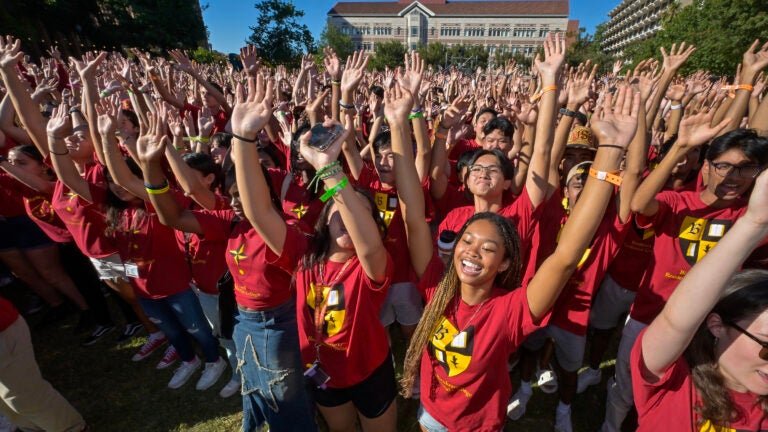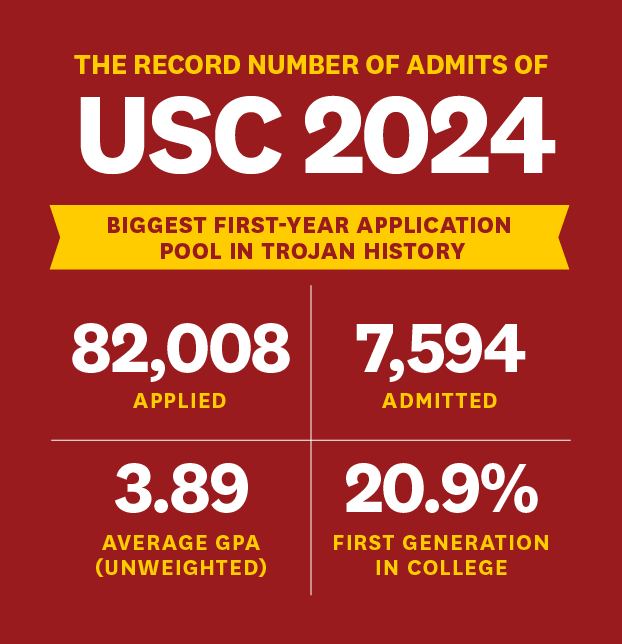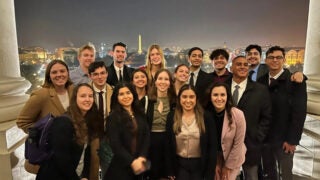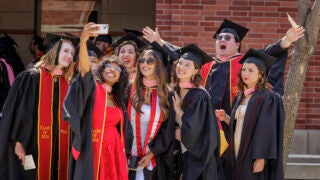
New USC students show their spirit. (USC Photo/Gus Ruelas)
A record 82,008 students apply to become first-year Trojans
Among them: sixty-five students from the USC Leslie and William McMorrow Neighborhood Academic Initiative, an all-time high.
From a record pool of 82,008 applicants, USC offered admission to 7,597 first-year students this spring. For Anyi Tan, a senior at Woodrow Wilson Senior High School in northeast Los Angeles, the decision was easy.
Tan applied to 12 universities, with her first choice being Georgetown University — followed by USC. But when she got into her top two choices, the future international relations major soon realized that she really wanted to be a Trojan.

“I felt like it was a better match for me,” Tan said. “I want to take advantage of the wide range of opportunities at USC, where students are encouraged to explore the different avenues they’re interested in.”
Tan is one of a record 65 first-year students admitted to USC who are members of the USC Leslie and William McMorrow Neighborhood Academic Initiative’s Class of 2024. NAI is a seven-year program that offers academic support and resources to prepare students from the neighborhoods closest to USC’s campuses for the academic rigors of college, admission and graduation.
The admitted NAI students are from Wilson and Lincoln high schools in East Los Angeles and the James A. Foshay Learning Center in South L.A.
“We’re just over the moon with joy for these families and these children — all of whom live in the neighborhoods closest to USC’s campuses,” said Kim Thomas-Barrios, associate senior vice president of USC Educational Partnerships, USC University Relations. “These NAI scholars have had USC in their sights for seven years now — and longer for some. They see USC and think, ‘I want to go there.’”
Joy for USC admits and families
NAI has a 100% high school graduation rate and a 99% college graduation rate. NAI program director Lizette Zarate said college acceptance is “the fruition of all the hard work” put in by the students and their families.
“The very first time we meet as a community of incoming sixth graders, we talk about the day when they will start opening all of their college acceptance letters and have to make decisions,” Zarate said. “We try to get the scholars and their families to visualize what that day will feel like, and how proud they will feel.”
Another Wilson student, Brandon Esquivel, and his family got to live out that dream recently at a taco stand, of all places.
As the family was grabbing lunch after a soccer game, Esquivel shared with his sister-in-law that he was waiting to see whether he had been accepted to USC. She encouraged him to check right away on his phone. Esquivel was so nervous that it took him five tries to log into the admissions portal.
“I was genuinely scared,” he said. “Then the first thing I saw was confetti and the word ‘Congratulations!’ I screamed to everyone: ‘I got in!’”
Both of his parents, two brothers, two sisters and his sister-in-law began to celebrate with hugs and tears. Once other customers realized why the family was making such a ruckus, those gathered around the taco stand began clapping.
“USC has always been my top choice — forever — and I thought it would be a miracle if I was able to attend,” said Esquivel, who also applied to several University of California and California State University schools, as well as backups.
Esquivel credits NAI with playing a “big role” in his admission: “They offered so much help in math and English and in academic advising.”
First in the family
A majority of NAI participants will become first-generation college students, which USC defines as students whose parents do not have four-year degrees. Overall, 1,585 (20.9%) of the first-year students admitted for the fall are first-generation.
USC Dean of Admission Timothy Brunold said these are “some of the most underrepresented students” on any research university or private research university campus.
“Our numbers have been steadily increasing in the past decade,” Brunold said. “In our recruiting practices, we are going to more high schools where there are more first-generation students. This is something we’re really interested in and a commitment we’ve made at the university.”
Of the admitted students, 345 of them are graduating from a school within the Los Angeles Unified School District while 167 students are known as STARS (Small-Town and Rural Students). STARS is an initiative to help students from small-town and rural America enroll in, succeed at and graduate from the undergraduate program of their choice. USC joined the STARS College Network, a partnership of 16 leading universities across the country, last year.
More first-year applicants than ever
The number of first-year student applicants to USC for fall 2024 was a 1.5% increase over last year’s total — a then-record 80,790. This historically high level of applicants drove the admission rate down to 9.3%, a record low.
Brunold believes the increase in applicants could be driven in part by recent additions to USC programs. These changes include a new joint undergraduate degree in artificial intelligence for business launched last fall by the USC Marshall School of Business in partnership with the USC Viterbi School of Engineering and, to be offered for the first time in the fall, a Bachelor of Science degree in real estate finance and development from a joint project of the USC Price School of Public Policy and USC Marshall.
The average GPA of admitted first-year students is 3.89 on a 4-point scale. Slightly more females than males were admitted, and 109 of the students (1.9%) are in the category of “another gender.”
USC does not use a waitlist. If there’s room in the fall 2024 class after the May 1 acceptance deadline, some students who committed to enrolling at USC in spring 2025 will be invited to move up their start date to fall.
“The students we’ve admitted are among the world’s best and brightest,” Brunold said. “We’re happy so many want to be Trojans, and I know they will have a great experience here.”



